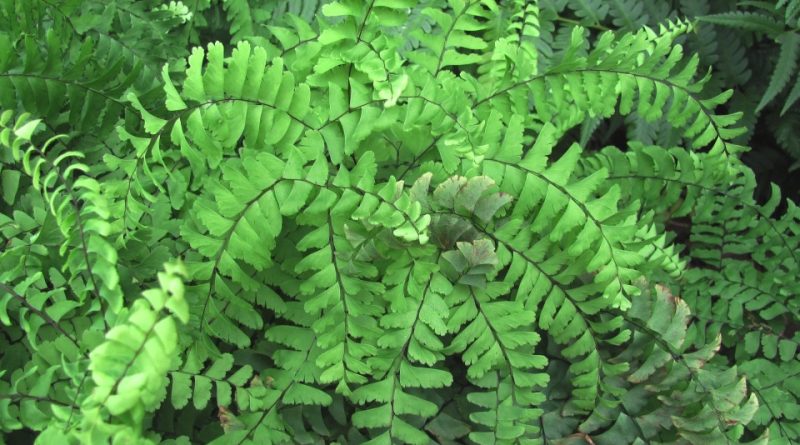Adiantum pedatum
Adiantum pedatum
The Maidenhair Fern (Adiantum pedatum L.) is a fern belonging to the Pteridaceae family.
Systematic –
From a systematic point of view, it belongs to the Eukaryota Domain, Plantae Kingdom, Pteridophyta Division, Polypodiopsida Class, Polypodiales Order, Pteridaceae Family and therefore to the Genus Adiantum and to the Species A. pedatum.
The terms are synonymous:
– Adiantum pedatum var. aleuticum Rupr .;
– Adiantum pedatum f. billingsae Kittr .;
– Adiantum pedatum var. kamtschaticum Rupr .;
– Adiantum pedatum f. laciniatum Weath .;
– Adiantum pedatum subsp. pedatum;
– Adiantum pedatum var. pedatum;
– Adiantum pedatum f. pedatum.
Furthermore, within this species, the variety Adiantum pedatum var. grandifolium (Ching) Ching.
Etymology –
The term Adiantum comes from adiantum, maidenhair in Pliny (from the Greek ἀδίαντον adíanton in Theophrastus, formed by the privative prefix α- a- and from διαίνω diáino to wet, soak): which does not get wet, reference to the water-repellent fronds of these ferns.
The specific epithet pedatum means in the shape of a bird’s foot or paw.
Geographical Distribution and Habitat –
The Maidenhair Fern is a fern native to the humid forests of eastern North America and widespread especially Alaska, Quebec and Nova Scotia, all the way to the south in California and Georgia.
Its habitat is somewhat varied but still tends to favor humus-rich, moist and well-drained soils; moreover, in the presence of adequate humidity conditions, it grows both in the hips on rocky walls and rocky ledges, where it grows from sea level up to 700 meters.
Description –
The Adiantum pedatum is a deciduous fern that can reach, in its original habitat, 30–75 cm, with the presence of distinctly bifurcated fronds and fins on one side and with a short rhizome.
The fronds have the appearance of a parasol (or an open hand), light and with a paper consistency, a beautiful bright green and are carried by thin black and shiny petioles.
The variety A. Imbricatum is more compact than the nominal species.
Cultivation –
The Maidenhair Fern is a slow-growing fern which, if cultivated, should be placed in the shade but not very dark garden.
The ideal substrate is moist and fertile, slightly acidic which contributes to better absorption especially of trace elements and better plant growth. it is a plant that can be satisfied, if planted in a crevasse, of a stony soil on condition of maintaining constant humidity.
This plant, out of its original habitat, if it finds the ideal conditions, can even reach 60 centimeters in height and grows through rhizomes and spores, without being invasive.
During the winter this fern enters vegetative rest, completely losing the aerial part.
In spring it emerges from the ground with new light green shoots, called pastoral.
Generally, the cultivation in the open ground does not create any problem, just pay attention to the slugs, which are fond of young branches.
Withstands temperatures down to – 15 ° C.
Uses and Traditions –
The Adiantum pedatum is a very decorative plant, also perfect for growing in pots.
It can be placed along a shady edge or in a wooded garden together with species typical of this habitat.
From the food point of view, although there are no reports of toxicity for this species, a number of ferns contain carcinogens, therefore it is advisable to be careful. In fact, many ferns also contain thiaminase, an enzyme that tends to remove the vitamin B complex from the body. Obviously, in small quantities, this enzyme does no harm to people who follow an adequate diet rich in vitamin B; large quantities can instead cause serious health problems.
It should be noted, however, that the enzyme is destroyed by heat or complete drying, therefore cooking the plant removes the thiaminase.
This plant is indicated, officially, as useful for the treatment and well-being of the nose and throat; it also helps the functionality of the mucous membranes and respiratory system and, moreover, fluidizes bronchial secretions.
Method of Preparation –
The Maidenhair Fern is a plant that could be used, even at a food level, with the aforementioned precautions while, at the officinal level, it is useful for therapies to help the respiratory system.
However, its main use remains that of cultivation for ornamental purposes.
Guido Bissanti
Sources
– Acta Plantarum – Flora of the Italian Regions.
– Wikipedia, the free encyclopedia.
– Treben M., 2000. Health from the Lord’s Pharmacy, Tips and experiences with medicinal herbs, Ennsthaler Editore
– Pignatti S., 1982. Flora of Italy, Edagricole, Bologna.
– Conti F., Abbate G., Alessandrini A., Blasi C. (edited by), 2005. An annotated checklist of the Italian vascular flora, Palombi Editore.
Warning: Pharmaceutical applications and alimurgical uses are indicated for information purposes only, they do not in any way represent a medical prescription; therefore, no responsibility is accepted for their use for healing, aesthetic or food purposes.


